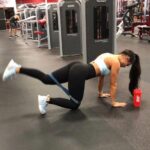Are you looking to enhance your fitness squats routine? Squats are a staple exercise for anyone looking to improve their strength, muscle growth, and overall fitness level. In this article, we will explore the various benefits of incorporating squats into your fitness routine, different types of squats, the importance of proper form and technique, common mistakes to avoid, advanced variations, and tips for maximizing results.
Squats are an essential component of any well-rounded fitness routine. They target multiple muscle groups simultaneously, making them a highly efficient exercise for building lower body strength. Additionally, squats can also promote better balance and stability while improving overall mobility and flexibility.
Understanding the different types of squats available will allow you to tailor your fitness routine to best meet your specific goals. From goblet squats to sumo squats and pistol squats, each variation targets muscles in unique ways. With the right execution and technique, you can maximize the benefits of each squat variation in your fitness routine.
Proper form and technique are crucial when performing squats to prevent injury and ensure optimal results. We will delve into the importance of maintaining proper alignment and positioning throughout the squat movement. By focusing on form, you can safely challenge yourself with increased resistance or advanced variations while minimizing the risk of injury.
Understanding the Different Types of Squats for Fitness
When it comes to incorporating squats into your fitness routine, it’s important to understand the different types of squats available to target different muscle groups and fitness goals. Each type of squat offers unique benefits and challenges, allowing you to customize your routine based on your personal fitness needs.
Traditional Squat
The traditional squat, also known as the bodyweight squat, is a foundational exercise that targets the quads, hamstrings, glutes, and core. This type of squat is perfect for beginners and can be performed anywhere without the need for equipment. It’s essential to focus on maintaining proper form and technique to avoid injury and maximize effectiveness.
Sumo Squat
The sumo squat is a variation of the traditional squat in which you position your feet wider than shoulder-width apart and angle your toes outward. This type of squat targets the inner thighs, glutes, and hamstrings more intensely than the traditional squat. It’s a great way to add variety to your routine and increase lower body strength.
Split Squat
The split squat, also known as the stationary lunge, is a unilateral exercise that focuses on each leg individually. This type of squat helps improve balance, stability, and overall leg strength. By isolating each leg, you can address muscle imbalances and prevent potential injuries from strength discrepancies between the right and left sides.
Understanding these different types of squats allows you to tailor your fitness squats routine to meet your specific goals – whether it’s building strength, improving muscle definition, or enhancing athletic performance. By incorporating a variety of squats into your routine, you can effectively target multiple muscle groups and achieve a well-rounded lower body workout.
The Importance of Proper Form and Technique in Squats
Proper form and technique are crucial when it comes to incorporating squats into your fitness routine. Whether you are a beginner or an experienced gym-goer, executing squats with the correct form is essential for preventing injury and maximizing effectiveness.
One of the most important aspects of proper squat form is maintaining a straight back throughout the exercise. This helps to prevent strain on the lower back and ensures that the focus remains on engaging the leg muscles. Additionally, it is essential to keep your knees in line with your toes and not let them extend past your toes to avoid unnecessary pressure on the knee joints.
Another key point in executing squats with proper technique is controlling the depth of your squat. While some people may have the flexibility to perform deep squats without issue, others may need to limit their range of motion to prevent discomfort or injury. It is important to find a depth at which you can comfortably achieve proper form while still engaging the muscles effectively.
Incorporating proper breathing techniques into your squats routine is also vital for maximizing performance and preventing dizziness or lightheadedness during the exercise. Many fitness experts recommend inhaling as you lower down into the squat and exhaling as you push back up, helping to stabilize your core and maintain energy throughout each rep.
| Importance | Details |
|---|---|
| Maintaining a straight back | Prevents strain on lower back & focuses on leg muscles |
| Knee alignment | Avoids unnecessary pressure on knee joints |
| Squat depth | Finding a comfortable range of motion for effective muscle engagement |
| Breathing techniques | Inhale as you lower down & exhale as you push back up for core stability & energy maintenance |
Creating a Personalized Squats Routine for Your Fitness Goals
When it comes to creating a personalized squats routine for your fitness goals, it’s important to consider your current fitness level, any injuries or limitations, and what you hope to achieve with your workouts. Below are some steps to help you create a customized squats routine that is tailored to your individual needs:
- Assess Your Current Fitness Level: Before starting any new fitness program, it’s essential to assess where you are currently at in terms of strength, flexibility, and overall fitness. This will help you determine the appropriate starting point for your squats routine.
- Set Clear Goals: Whether you want to build muscle, improve lower body strength, or increase overall endurance, setting clear and achievable goals will guide the structure of your squats routine.
- Select Squat Variations: Depending on your goals and fitness level, choose the types of squats that align with what you want to achieve. This could include traditional squats, sumo squats, goblet squats, or other variations.
It’s important to remember that consistency is key when it comes to seeing results from your fitness squats routine. By following these steps and staying dedicated to your personalized plan, you can make progress towards achieving your desired fitness goals while reaping the many benefits of incorporating squats into your workout regimen.
Incorporating Squats Into a Full-Body Workout
Benefits of Full-Body Workouts
Full-body workouts offer numerous advantages, including the ability to engage multiple muscle groups simultaneously, increase calorie burn, and improve overall functional fitness. By incorporating squats into a full-body workout, you can optimize your time at the gym and achieve more comprehensive results.
Integrating Squats Into Your Routine
When integrating squats into a full-body workout, it’s essential to consider proper form and technique. Start by performing bodyweight squats to warm up the muscles and prepare for more challenging variations. As you progress, gradually incorporate weighted squats using dumbbells or a barbell to add resistance and further stimulate muscle growth.
Including other compound exercises such as deadlifts, lunges, and push-ups can complement the effects of squats in a full-body workout. By combining these movements, you can create a well-rounded routine that enhances strength, stability, and overall physical conditioning.
Sample Full-Body Workout Featuring Squats
A sample full-body workout featuring squats could include bodyweight squats, followed by weighted barbell or dumbbell squats. This could be paired with deadlifts for the lower body, bench press for the upper body, and planks for core stability. By incorporating a variety of exercises that target different muscle groups, you can create a balanced routine that maximizes the benefits of incorporating squats into your fitness regimen.
Common Mistakes to Avoid When Doing Squats
When it comes to incorporating squats into your fitness routine, it’s important to avoid common mistakes that can lead to injury or hinder your progress. Here are some key points to keep in mind when performing squats:
- Proper form is crucial: One of the most common mistakes people make when doing squats is not maintaining proper form. This includes keeping your chest up, back straight, and knees in line with your toes. Failing to maintain proper form can put unnecessary strain on your lower back and knees.
- Don’t rush the movement: Another mistake to avoid is rushing through the squat movement. It’s important to lower yourself down slowly and then push back up through your heels with control. Rushing through the movement increases the risk of injury and reduces the effectiveness of the exercise.
- Using too much weight: Many people make the mistake of using weights that are too heavy for their current strength level. This can compromise your form and increase the risk of injury. Start with a comfortable weight and gradually increase as you build strength.
By being mindful of these common mistakes, you can ensure that you’re getting the most out of your squats routine while minimizing the risk of injury.
Remember, always consult with a fitness professional before starting any new exercise routine, especially if you have existing health concerns or injuries. With proper guidance and attention to form, squats can be an effective addition to any fitness routine, helping you build strength and improve overall stability.
Advanced Squat Variations for a Challenging Fitness Routine
When it comes to taking your fitness squats routine to the next level, incorporating advanced squat variations can be an effective way to challenge your muscles and improve overall strength and endurance. These advanced variations target different muscle groups and add an extra level of difficulty to your workout, leading to greater fitness gains.
One popular advanced squat variation is the Bulgarian split squat, which places more emphasis on each leg individually. This exercise not only works the quadriceps, hamstrings, and glutes but also engages the stabilizing muscles in the hips and core.
Another challenging variation is the pistol squat, which requires significant strength and balance as it involves lowering down into a squat on just one leg. Adding these advanced squat variations to your routine can lead to increased lower body strength, stability, and mobility.
In addition to the Bulgarian split squat and pistol squat, there are many other advanced variations that can be incorporated into a challenging fitness squats routine. From jump squats to weighted squats with resistance bands or kettlebells, these variations provide a diverse range of movements that engage different muscle groups while keeping the workout exciting and dynamic. By regularly changing up your squat routine with these advanced variations, you can continue to see progress in your fitness journey.
Finally, when incorporating advanced squat variations into your fitness routine, it’s important to focus on maintaining proper form and technique. This will not only help prevent injury but also ensure that you are effectively targeting the intended muscle groups. Working with a qualified fitness professional can help ensure that you are performing these advanced variations correctly for optimal results.
| Advanced Squat Variation | Targeted Muscle Groups |
|---|---|
| Bulgarian Split Squat | Quadriceps, Hamstrings, Glutes |
| Pistol Squat | Legs muscles balance stability |
| Jump Squats | Full lower body including calves |
The Science Behind How Squats Improve Strength and Muscle Growth
Squats are a fundamental exercise in any fitness routine, and for good reason. The science behind how squats improve strength and muscle growth is fascinating and important to understand. When you perform squats, you engage multiple large muscle groups, including the quadriceps, hamstrings, glutes, and lower back muscles. This means that squats are an incredibly efficient way to build overall lower body strength and muscle mass.
One of the key factors in how squats improve strength and muscle growth is the principle of progressive overload. By consistently increasing the weight or resistance used during squat exercises, you can continually challenge your muscles, leading to increased strength and size over time. This process stimulates muscle fibers to repair and grow larger, resulting in greater overall muscle mass and strength.
Additionally, the biomechanics of a squat play a significant role in its effectiveness for improving strength and muscle growth. During a squat, your body recruits stabilizing muscles throughout your core and lower body to maintain proper form and balance. Over time, this helps to strengthen these supporting muscles as well as the primary muscles being targeted during the exercise. This not only improves overall body stability but also contributes to increased full-body strength and muscular development.
Incorporating squats into your fitness routine can lead to significant improvements in functional strength, balance, and overall muscular development. By understanding the science behind how squats improve strength and muscle growth, you can better appreciate the importance of this foundational exercise in achieving your fitness goals. Keep in mind that proper form, technique, and progression are essential for maximizing the benefits of squats within your personalized fitness routine.
Tips for Maximizing Results From Your Squats Routine
In conclusion, incorporating squats into your fitness routine can have numerous benefits for overall strength, muscle growth, and functional movement. Understanding the different types of squats and the importance of proper form and technique is essential for maximizing results and minimizing the risk of injury. By creating a personalized squats routine tailored to your fitness goals and incorporating squats into a full-body workout, you can optimize the effectiveness of this exercise.
One important aspect to keep in mind when doing squats is to avoid common mistakes that could hinder your progress. Maintaining good form, listening to your body, and being mindful of any discomfort or pain is crucial for long-term success. Additionally, exploring advanced squat variations can add challenge and variety to your routine, keeping your muscles engaged and continuously improving.
The science behind how squats improve strength and muscle growth is well-documented, with studies showing that this compound exercise activates multiple muscle groups simultaneously. To maximize results from your squats routine, it’s important to stay consistent, progressively overload the muscles, and maintain proper nutrition and rest. By following these tips for maximizing results from your fitness squats routine, you can effectively harness the power of this exercise for a stronger, fitter body.
Frequently Asked Questions
How Many Squats You Should Do a Day?
The number of squats you should do in a day will vary depending on your fitness level, goals, and physical condition. Generally, starting with 3 sets of 10-15 squats is a good beginning point.
What Is a Good Squat Routine?
A good squat routine will typically include a mix of bodyweight squats, weighted squats (using dumbbells or barbells), and different variations like sumo squats or jump squats. It’s important to also incorporate rest days for muscle recovery.
What Is the 100 Squats a Day Rule?
The “100 squats a day” rule is a popular fitness challenge that involves doing 100 squats every day for a certain period. While it can be a good way to build lower body strength and endurance, it’s crucial to ensure proper form and listen to your body to avoid overtraining or injury.

Passionate about providing useful information to anyone with an interest in the field of Personal Training, I strive to pass on to our readers quality information and to answer any questions about Personal Trainers, the work they do and how to become one.





